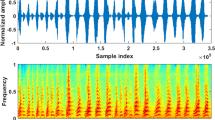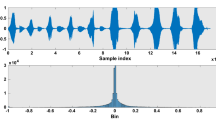Abstract
This paper explores the necessity of having hearing impaired (HI) and dysarthric speakers be part of the person authentication system and it is considered to be imperative. Automated system on identifying speakers is evaluated by having the perceptual features with critical band analysis done in various non-linear frequency scales and vector quantization (VQ) & Fuzzy C means (FCM) based iterative clustering templates and multi-variant hidden Markov (MHMM) models as representative of HI or dysarthric speakers. For developing a training system, perceptual features are extracted from the speeches of HI or dysarthric speakers after the initial pre-processing techniques namely voice activity detection, pre-emphasis, frame blocking, and windowing contemplated on the speech utterances, and VQ & FCM clustering models and MHMM models are created for each speaker and the study is done on varying cluster and mixture size. The testing phase emphasizes the extraction of features from the test utterances, application of features to the templates, and classification is done based on minimum distance criterion for clustering technique and maximum log-likelihood criterion for MHMM technique. This algorithm gives the overall accuracy of 100% when the decision level fusion classification is done for the perceptual features with critical band analysis done in MEL, BARK, and ERB scales for all the clusters with variations in cluster size for both hearing impaired and dysarthric speaker recognition. Decision level fusion classification using FCM and MHMM technique provides low overall accuracy as compared to the VQ technique.





















Similar content being viewed by others
Data availability
All relevant data are within the paper and its supporting information files.
References
Ahlawat S, Choudhary A, Nayyar A, Singh S, Yoon B (2020) Improved handwritten digit recognition using convolutional neural networks (CNN). Sensors 20(12):3344. https://doi.org/10.3390/s20123344
Andrade AN, MartinelliIorio MC, Gil D (2016) Speech recognition in individuals with sensorineural hearing loss. Braz J Otorhinolaryngol 82(3):334–340. https://doi.org/10.1016/j.bjorl.2015.10.002
Chin Y-H, Tai T-C, Zhao J-H, Wang K-Y, Hong C-T, Wang J-C (2017) Program Guardian: screening system with a novel speaker recognition approach for smart TV. Multimedia Tools and Applications 76(120):13881–13896. https://doi.org/10.1007/s11042-016-3764-9
Dargan S, Kumar M (2020) A comprehensive survey on the biometric recognition systems based on physiological and behavioral modalities. Expert Syst Appl 143:113114. https://doi.org/10.1016/j.eswa.2019.113114
Dargan S, Kumar M, Garg A, Thakur K (2020) Writer identification system for pre-segmented offline handwritten Devanagari characters using k-NN and SVM. Soft Comput 24:10111–10122. https://doi.org/10.1007/s00500-019-04525-y
Farhadipour A, Veisi H, Asgari M, Keyvanrad MA (2018) Dysarthric speaker identification with different degrees of dysarthria severity using deep belief networks. J ETRI 40(5):643–652. https://doi.org/10.4218/etrij.2017-0260
Fink N, Furst M, Muchnik C (2012) Improving word recognition in noise among hearing-impaired subjects with a single-channel cochlear noise-reduction algorithm. J Acoust Soc Am 132:1718–1731. https://doi.org/10.1121/1.4739441
Gadekallu TR, Khare N, Bhattacharya S, Singh S, Reddy Maddikunta PK, Ra IH, Alazab M (2020) Early detection of diabetic retinopathy using PCA-firefly based deep learning model. Electronics 9(2):274. https://doi.org/10.3390/electronics9020274
Ghezaiel W, Slimane AB, Braiek EB (2017) Non-linear multi-scale decomposition by EMD for Co-Channel speaker identification. Multimed Tools Appl 76(20):20973–20988. https://doi.org/10.1007/s11042-016-4044-4
Healy EW, Vasko JL, Wang DL (2019) The optimal threshold for removing noise from the speech is similar across normal and impaired hearing—a time-frequency masking study. J Acoust Soc Am 145(6):EL581. https://doi.org/10.1121/1.5112828
Healy EW, Yoho SE, Wang Y, Apoux F, Wang DL (2014) Speech-cue transmission by an algorithm to increase consonant recognition in noise for hearing-impaired listeners. J Acoust Soc Am 136:3325–3336. https://doi.org/10.1121/1.4901712
Healy EW, Yoho SE, Wang Y, Wang D (2013) An algorithm to improve speech recognition in noise for hearing-impaired listeners. J Acoust Soc Am 134:3029–3038 https://www.ncbi.nlm.nih.gov/pmc/articles/PMC3799726/
Hermansky H, Margon N, Bayya A, Kohn P (1991) The challenge of inverse E: the RASTA PLP method. Proc Twenty-Fifth IEEE Asilomar Conf Signals Syst Comput 2:800–804. https://doi.org/10.1109/ACSSC.1991.186557
Hermansky H, Morgan N (1994) RASTA processing of speech. IEEE Trans Speech Audio Process 2(4):578–589. https://doi.org/10.1109/89.326616
Hermansky H, Tsuga K, Makino S, Wakita H (1986) Perceptually based processing in automatic speech recognition. Proc IEEE Int Conf Acoust Speech Signal Process 11:1971–1974. https://doi.org/10.1109/ICASSP.1986.1168649
Jürgens T, Ewert SD, Kollmeier B, Brand T (2014) Prediction of consonant recognition in quiet for listeners with normal and impaired hearing using an auditory model. J Acoust Soc Am 135:1506–1517. https://doi.org/10.1121/1.4976054
Khare N, Devan P, Chowdhary CL, Bhattacharya S, Singh G, Singh S, Yoon B (2020) SMO-DNN: Spider Monkey Optimization and Deep Neural Network Hybrid Classifier Model for Intrusion Detection. Electronics 9(4):692. https://doi.org/10.3390/electronics9040692
Kumar M, Jindal SR, Jindal MK, Lehal GS (2020) Improved recognition results of medieval handwritten Gurmukhi manuscripts using boosting and bagging methodologies. Neural Process Lett 50(1):43–56 https://www.springerprofessional.de/en/improved-recognition-results-of-medieval-handwritten-gurmukhi-ma/16108768
Kumar M, Jindal MK, Sharma RK, Jindal SR (2018) Offline handwritten numeral recognition using combination of different feature extraction techniques. Natl Acad Sci Lett 41:29–33. https://doi.org/10.1007/s40009-017-0606-x
Kumar M, Jindal MK, Sharma RK et al (2020) Performance evaluation of classifiers for the recognition of offline handwritten Gurmukhi characters and numerals: a study. Artif Intell Rev 53:2075–2097. https://doi.org/10.1007/s10462-019-09727-2
Kumar M, Singh N, Kumar R, Goel S, Kumar K (2021) Gait recognition based on vision systems: a systematic survey. J Vis Commun Image Represent 75:103052. https://doi.org/10.1016/j.jvcir.2021.103052
LahceneKadi K, AhmedSelouani S, Boudraa B, Boudraa M (2016) Fully automated speaker identification and intelligibility assessment in dysarthria disease using auditory knowledge. Bio-cybern Biomed Eng 36(1):233–247. https://doi.org/10.1016/j.bbe.2015.11.004
Li Z, Gao Y (2015) Acoustic feature extraction method for robust speaker identification. Multimed Tools Appl 75(12):7391–7406. https://doi.org/10.1007/s11042-015-2660-z
Li B, Guo Y, Yang G, Feng Y, Yin S (2017) Effects of various extents of high-frequency hearing loss on speech recognition and gap detection at low frequencies in patients with sensorineural hearing loss. Neural Plast 2017:1–9. https://doi.org/10.1155/2017/8941537
Li Z-Y, Zhang W-Q, Liu J (2015) Multi-resolution time-frequency feature and complementary combination for short utterance speaker recognition. Multimed Tools Appl 74(3):937–953. https://doi.org/10.1007/s11042-013-1705-4
Luque-Suárez F, Camarena-Ibarrola A, Chávez E (2019) Efficient speaker identification using spectral entropy. Multimedia Tools and Applications 78(12):16803–16815. https://doi.org/10.1007/s11042-018-7035-9
Moro-Velázquez L, Gómez-Garcíaa JA, Godino-Llorentea JI, Villalba J, Orozco-Arroyavec JR, Dehak N (2018) Analysis of speaker recognition methodologies and the influence of kinetic changes to automatically detect Parkinson’s disease. J Appl Soft Comput 62:649–666. https://doi.org/10.1016/j.asoc.2017.11.001
Neher T, Lougesen S, Jensen NS, Kragelund L (2011) Can basic auditory and cognitive measures predict hearing-impaired listeners localization and spatial speech recognition abilities? J Acoust Soc Am 130:1542–1558. https://doi.org/10.1121/1.3608122
Neher T, Lunner T (2012) Binaural temporal fine structure sensitivity, cognitive function and spatial speech recognition of hearing-impaired listeners. J Acoust Soc Am 131:2561–2564. https://doi.org/10.1121/1.3689850
Rabiner L, Juang BH (1993) Fundamentals of speech recognition. Prentice-Hall, NJ
Revathi A, Venkataramani Y (2008) Iterative clustering approach for text-independent speaker identification using multiple features. Proc Int Conf Signal Process Commun Syst. https://doi.org/10.1109/ICSPCS.2008.4813764
Revathi A, Venkataramani Y (2009) Text independent composite speaker identification/verification using multiple features. Int Conf Comput Sci Inf Eng. https://doi.org/10.1109/CSIE.2009.926
Singh A, Kadyan V, Kumar M, Bassan N (2020) ASRoIL: a comprehensive survey for automatic speech recognition of Indian languages. Artif Intell Rev 5:1–32 https://www.springerprofessional.de/en/asroil-a-comprehensive-survey-for-automatic-speech-recognition-o/17266068
Tiwari V, Hashmi MF, Keskar A, Shivaprakash NC (2020) Virtual home assistant for voice-based controlling and scheduling with short speech speaker identification. Multimed Tools Appl 2020:1–26. https://doi.org/10.1007/s11042-018-6358-x
Acknowledgements
It is our work - no grant & contribution numbers.
Author information
Authors and Affiliations
Corresponding author
Ethics declarations
As the authors of the manuscript, we do not have a direct financial relationship with the commercial Identity mentioned in our paper that might lead to a conflict of interest for any of the authors.
Competing interests
The authors have declared that no competing interest exists.
Additional information
Publisher’s note
Springer Nature remains neutral with regard to jurisdictional claims in published maps and institutional affiliations.
Rights and permissions
About this article
Cite this article
Revathi, A., Nagakrishnan, R. & Sasikaladevi, N. Robust HI and dysarthric speaker recognition – perceptual features and models. Multimed Tools Appl 81, 8215–8233 (2022). https://doi.org/10.1007/s11042-022-12184-9
Received:
Revised:
Accepted:
Published:
Issue Date:
DOI: https://doi.org/10.1007/s11042-022-12184-9




